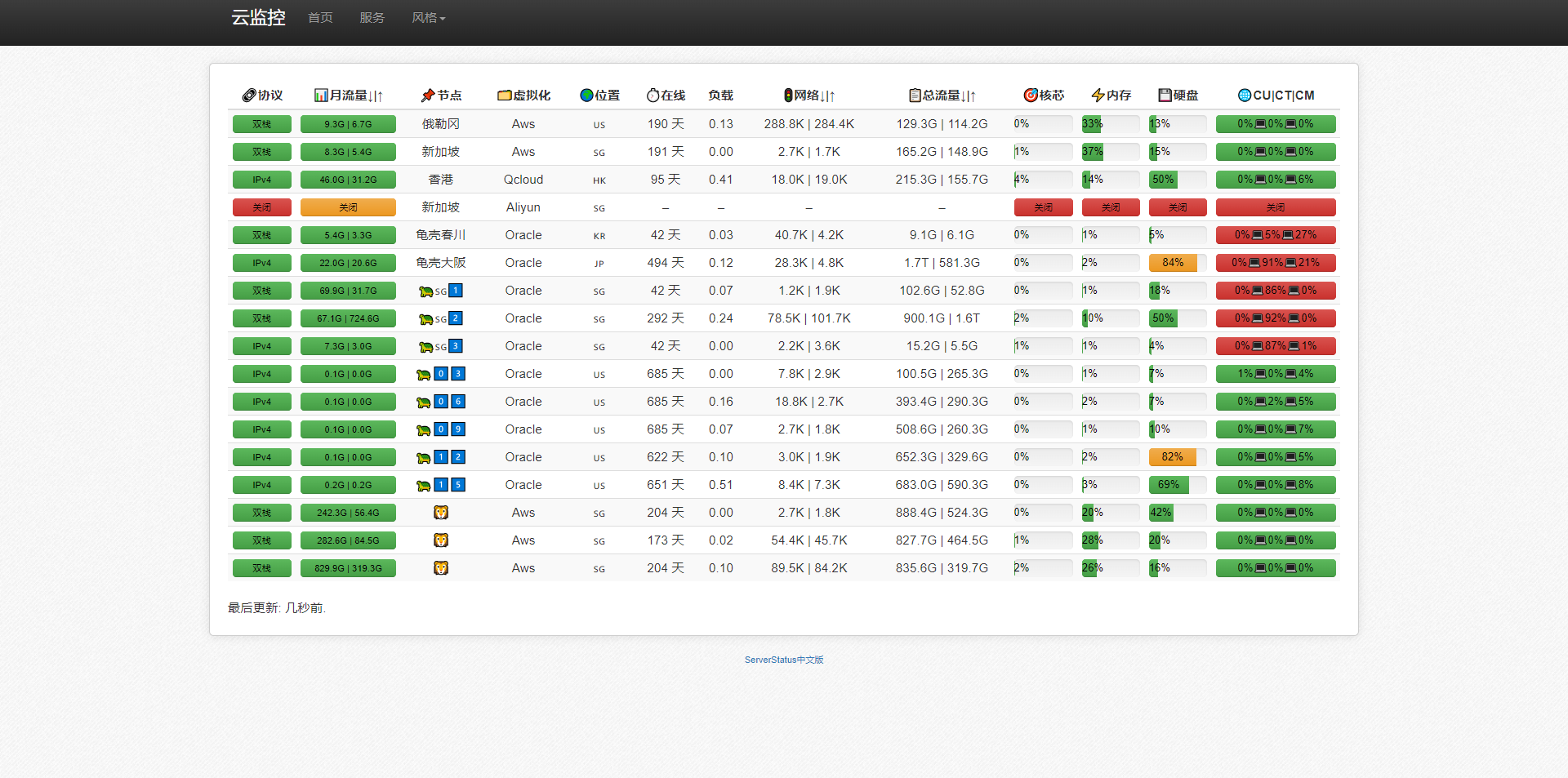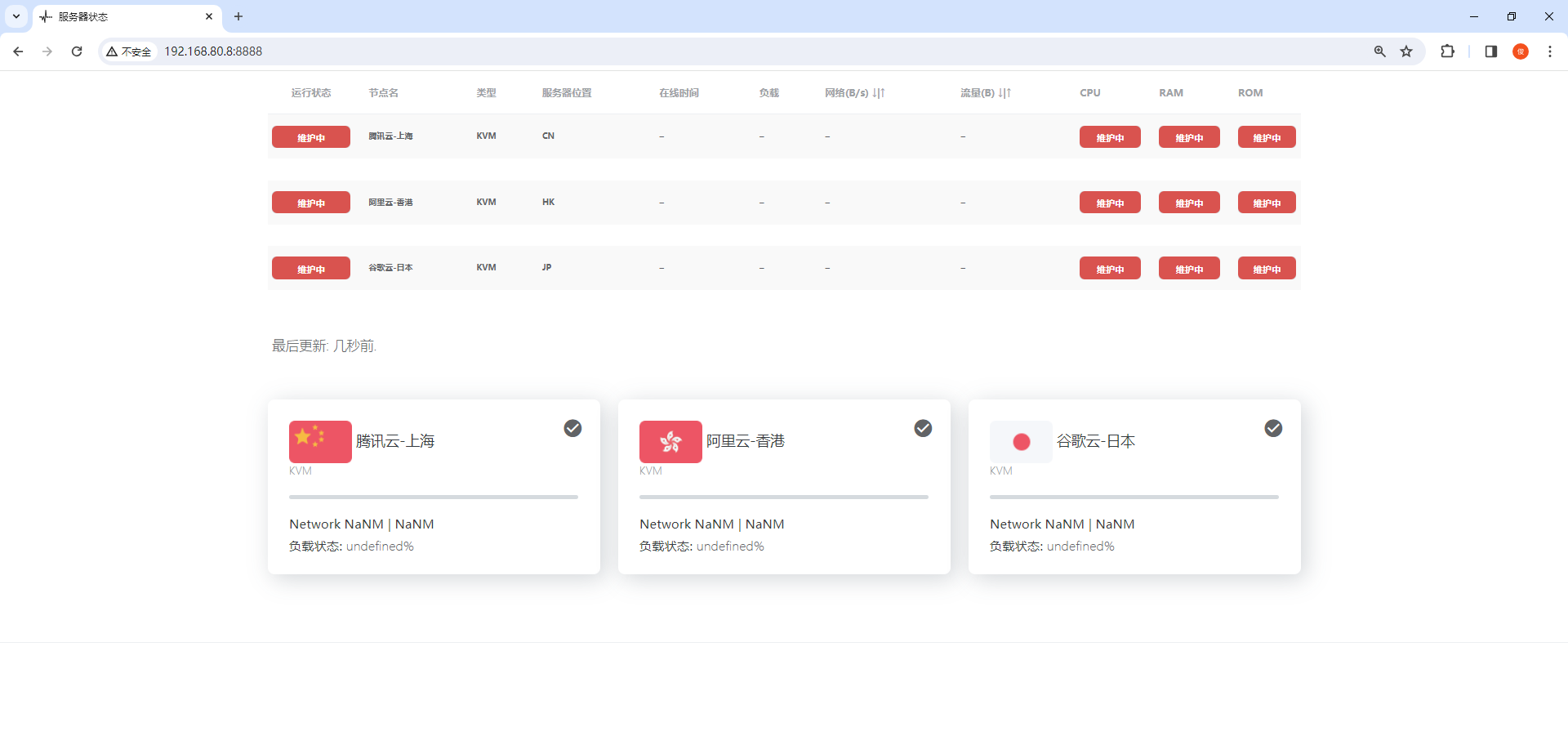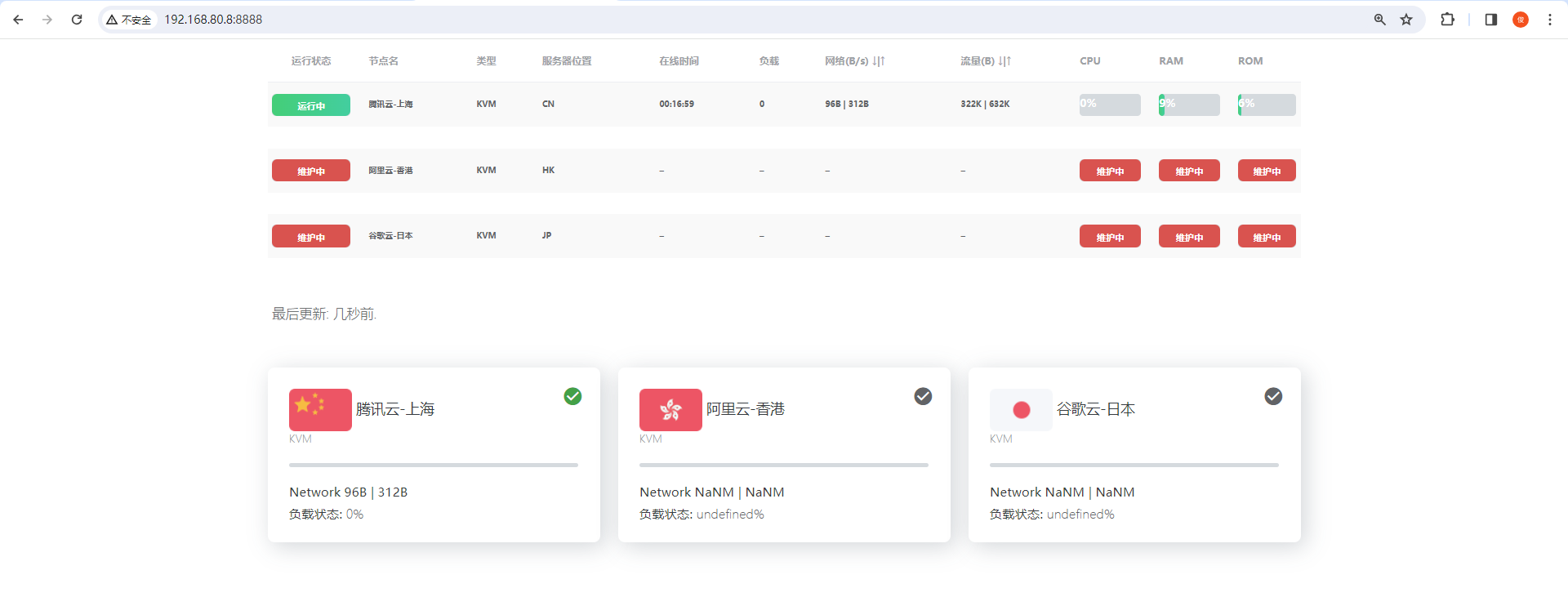一、ServerStatus 介绍
ServerStatus 是一个酷炫高逼格的云探针、云监控、服务器云监控、多服务器探针~。
ServerStatus开源地址:https://github.com/cppla/ServerStatus
### 特性
+ 使用 Rust 完全重写 Server、Client,单个执行文件部署
+ 支持上下线和简单自定义规则告警 (Telegram、 Wechat、 Email、 Webhook)
+ 支持 http 协议上报,可以方便部署到各免费容器服务和配合 cf 等优化上报链路
+ 支持 vnstat 统计月流量,重启不丢流量数据
+ 支持 Railway 快速部署
+ 支持 Systemd 开机自启

二、检查宿主机系统版本
cat /etc/os-release
三、检查本地 Docker 环境
检查 Docker 服务状态
// 1) 低版本 Docker 安装yum install docker -y----// < '推荐' >// 2) 高版本 Docker 安装curl -fsSL https://get.docker.com/ | sh----// 关闭防火墙systemctl disable --now firewalldsetenforce 0// 启用 Dockersystemctl enable --now docker
检查 Docker 配置信息
docker info
开启 IPv4 forwarding
echo "net.ipv4.ip_forward=1" >> /etc/sysctl.confsystemctl restart networksysctl net.ipv4.ip_forward
四、安装 Docker-compose
下载 Docker-compose 二进制包
curl -L https://github.com/docker/compose/releases/download/v2.2.2/docker-compose-linux-x86_64 -o /usr/local/bin/docker-compose
给文件增加执行权限
chmod +x /usr/local/bin/docker-compose
检查 Docker-compose 版本
docker-compose -v
五、下载 ServerStatus 镜像
docker pull stilleshan/serverstatus
六、使用 Docker-cli 部署
mkdir /docker/ServerStatus/server -p && cd /docker/ServerStatus/server
( 省略 )docker run -d --name=serverstatus --restart=always \ -p 8888:80 \ -p 35601:35601 \ -v /docker/ServerStatus/server/config.json:/ServerStatus/server/config.json \ stilleshan/serverstatus
七、下载 ServerStatus 安装文件
创建数据目录
mkdir /docker/ServerStatus/server -p && cd /docker/ServerStatus/server
下载安装文件
yum install git -y
git clone https://github.com/stilleshan/ServerStatus.git
[root@localhost ServerStatus]# lsconfig.json docker-compose.yml Dockerfile README.md screenshot.jpg status.sh web
查看 Docker-compose.yaml 文件
[root@localhost ServerStatus]# vim docker-compose.ymlversion: "3"services: serverstatus: image: stilleshan/serverstatus container_name: serverstatus ports: - 8888:80 - 35601:35601 volumes: # - ./web:/usr/share/nginx/html - ./config.json:/ServerStatus/server/config.json environment: TZ: Asia/Shanghai restart: always
创建 ServerStatus 容器
docker-compose up -d
查看 ServerStatus 容器状态
docker ps

八、访问 ServerStatus 服务端

九、客户端安装
修改 status-client.py
[root@node01 ~] vim status-client.py # -*- coding: utf-8 -*-SERVER = "192.168.80.8" # 填写服务器地址PORT = 35601USER = "admin" # 设置账号 ( 待会需要在服务端填写 )PASSWORD = "admin" # 设置密码 ( 待会需要在服务端填写 )INTERVAL = 1 # 更新间隔, 单位: 秒import socketimport timeimport stringimport mathimport reimport osimport jsonimport subprocessimport collectionsimport platformdef get_uptime(): f = open('/proc/uptime', 'r') uptime = f.readline() f.close() uptime = uptime.split('.', 2) time = int(uptime[0]) return int(time)def get_memory(): re_parser = re.compile(r'^(?P<key>\S*):\s*(?P<value>\d*)\s*kB') result = dict() for line in open('/proc/meminfo'): match = re_parser.match(line) if not match: continue; key, value = match.groups(['key', 'value']) result[key] = int(value) MemTotal = float(result['MemTotal']) MemFree = float(result['MemFree']) Cached = float(result['Cached']) MemUsed = MemTotal - (Cached + MemFree) SwapTotal = float(result['SwapTotal']) SwapFree = float(result['SwapFree']) return int(MemTotal), int(MemUsed), int(SwapTotal), int(SwapFree)def get_hdd(): p = subprocess.check_output(['df', '-Tlm', '--total', '-t', 'ext4', '-t', 'ext3', '-t', 'ext2', '-t', 'reiserfs', '-t', 'jfs', '-t', 'ntfs', '-t', 'fat32', '-t', 'btrfs', '-t', 'fuseblk', '-t', 'zfs', '-t', 'simfs', '-t', 'xfs']).decode("Utf-8") total = p.splitlines()[-1] used = total.split()[3] size = total.split()[2] return int(size), int(used)def get_load(): system = platform.linux_distribution() if system[0][:6] == "CentOS": if system[1][0] == "6": tmp_load = os.popen("netstat -anp |grep ESTABLISHED |grep tcp |grep '::ffff:' |awk '{print $5}' |awk -F ':' '{print $4}' |sort -u |grep -E -o '([0-9]{1,3}[\.]){3}[0-9]{1,3}' |wc -l").read() else: tmp_load = os.popen("netstat -anp |grep ESTABLISHED |grep tcp6 |awk '{print $5}' |awk -F ':' '{print $1}' |sort -u |grep -E -o '([0-9]{1,3}[\.]){3}[0-9]{1,3}' |wc -l").read() else: tmp_load = os.popen("netstat -anp |grep ESTABLISHED |grep tcp6 |awk '{print $5}' |awk -F ':' '{print $1}' |sort -u |grep -E -o '([0-9]{1,3}[\.]){3}[0-9]{1,3}' |wc -l").read() return float(tmp_load)#return os.getloadavg()[0]def get_time(): stat_file = file("/proc/stat", "r") time_list = stat_file.readline().split(' ')[2:6] stat_file.close() for i in range(len(time_list)) : time_list[i] = int(time_list[i]) return time_listdef delta_time(): x = get_time() time.sleep(INTERVAL) y = get_time() for i in range(len(x)): y[i]-=x[i] return ydef get_cpu(): t = delta_time() st = sum(t) if st == 0: st = 1 result = 100-(t[len(t)-1]*100.00/st) return round(result)class Traffic: def __init__(self): self.rx = collections.deque(maxlen=10) self.tx = collections.deque(maxlen=10) def get(self): f = open('/proc/net/dev', 'r') net_dev = f.readlines() f.close() avgrx = 0; avgtx = 0 for dev in net_dev[2:]: dev = dev.split(':') if dev[0].strip() == "lo" or dev[0].find("tun") > -1: continue dev = dev[1].split() avgrx += int(dev[0]) avgtx += int(dev[8]) self.rx.append(avgrx) self.tx.append(avgtx) avgrx = 0; avgtx = 0 l = len(self.rx) for x in range(l - 1): avgrx += self.rx[x+1] - self.rx[x] avgtx += self.tx[x+1] - self.tx[x] avgrx = int(avgrx / l / INTERVAL) avgtx = int(avgtx / l / INTERVAL) return avgrx, avgtxdef liuliang(): NET_IN = 0 NET_OUT = 0 with open('/proc/net/dev') as f: for line in f.readlines(): netinfo = re.findall('([^\s]+):[\s]{0,}(\d+)\s+(\d+)\s+(\d+)\s+(\d+)\s+(\d+)\s+(\d+)\s+(\d+)\s+(\d+)\s+(\d+)\s+(\d+)\s+(\d+)', line) if netinfo: if netinfo[0][0] == 'lo' or 'tun' in netinfo[0][0] or netinfo[0][1]=='0' or netinfo[0][9]=='0': continue else: NET_IN += int(netinfo[0][1]) NET_OUT += int(netinfo[0][9]) return NET_IN, NET_OUTdef get_network(ip_version): if(ip_version == 4): HOST = "192.168.80.18" # 客户端地址 elif(ip_version == 6): HOST = "ipv6.google.com" try: s = socket.create_connection((HOST, 80), 2) return True except: pass return Falseif __name__ == '__main__': socket.setdefaulttimeout(30) while 1: try: print("Connecting...") s = socket.socket(socket.AF_INET, socket.SOCK_STREAM) s.connect((SERVER, PORT)) data = s.recv(1024) if data.find("Authentication required") > -1: s.send(USER + ':' + PASSWORD + '\n') data = s.recv(1024) if data.find("Authentication successful") < 0: print(data) raise socket.error else: print(data) raise socket.error print(data) data = s.recv(1024) print(data) timer = 0 check_ip = 0 if data.find("IPv4") > -1: check_ip = 6 elif data.find("IPv6") > -1: check_ip = 4 else: print(data) raise socket.error traffic = Traffic() traffic.get() while 1: CPU = get_cpu() NetRx, NetTx = traffic.get() NET_IN, NET_OUT = liuliang() Uptime = get_uptime() Load = get_load() MemoryTotal, MemoryUsed, SwapTotal, SwapFree = get_memory() HDDTotal, HDDUsed = get_hdd() array = {} if not timer: array['online' + str(check_ip)] = get_network(check_ip) timer = 10 else: timer -= 1*INTERVAL array['uptime'] = Uptime array['load'] = Load array['memory_total'] = MemoryTotal array['memory_used'] = MemoryUsed array['swap_total'] = SwapTotal array['swap_used'] = SwapTotal - SwapFree array['hdd_total'] = HDDTotal array['hdd_used'] = HDDUsed array['cpu'] = CPU array['network_rx'] = NetRx array['network_tx'] = NetTx array['network_in'] = NET_IN array['network_out'] = NET_OUT s.send("update " + json.dumps(array) + "\n") except KeyboardInterrupt: raise except socket.error: print("Disconnected...") # keep on trying after a disconnect s.close() time.sleep(3) except Exception as e: print("Caught Exception:", e) s.close() time.sleep(3)
在客户端运行 status-client.py 脚本
[root@node01 ~] python status-client.py &[1] 105194
服务端配置
修改 config.json 文件,必须配置项为 username/password/host
[root@server ServerStatus] vim config.json {"servers": [ { "username": "admin", # 客户端账号 "password": "admin", # 客户端密码 "name": "腾讯云-上海", "type": "KVM", "host": "192.168.80.18", # 填写客户端 IP 地址 "location": "CN", "disabled": false }, { "username": "2", "password": "xxx", "name": "阿里云-香港", "type": "KVM", "host": "None", "location": "HK", "disabled": false }, { "username": "3", "password": "xxxx", "name": "谷歌云-日本", "type": "KVM", "host": "None", "location": "JP", "disabled": false } ]}
在 Web 监控页查看效果

大功告成~





